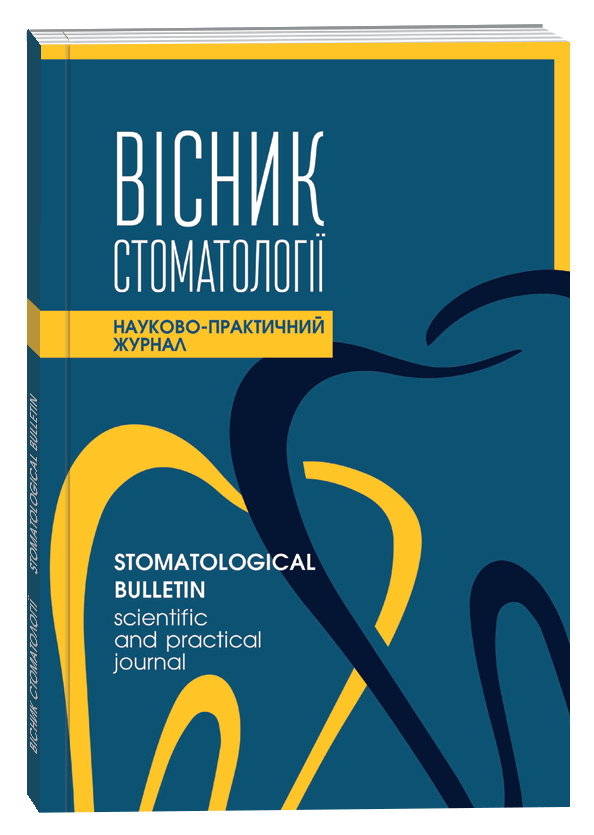INDEX ASSESSMENT OF THE CONDITION OF THE DENTAL SYSTEM OF ORTHODONTIC PATIENTS IN THE LONG TERM AFTER TREATMENT
DOI:
https://doi.org/10.35220/2078-8916-2023-48-2.22Keywords:
ICON (Index of Complexity, Outcome and Need), aesthetic component of IOTN, dental anomaliesAbstract
The maxillofacial area usually attracts special attention of people during interpersonal interactions and is the main source of voice, physical and emotional communication. As a result, patients seeking orthodontic treatment are concerned about improving their appearance and social recognition, often more than improving oral function or health. The need for orthodontic treatment in each case is determined subjectively by the orthodontist. That is why it is necessary to have criteria for determining the need for orthodontic treatment, its complexity and evaluation of results.The purpose of the study. To substantiate the feasibility of using a patient survey and the ICON index in the long term after orthodontic treatment. Material and research methods. In order to study the opinion of patients about the results and need for orthodontic treatment during 2019–2022, a survey of 118 patients aged 20–30 years who applied for dental care was conducted. The questionnaire contains 17 questions. An index assessment of the need and complexity of orthodontic treatment was carried out in 78 patients: 57 people after treatment, 17 people who believed that they did not have orthodontic pathology and 4 people who refused treatment. The method of comprehensive index assessment of the need, complexity and result of ICON orthodontic treatment consists of five components: the first component is the assessment of the aesthetics of the patient's bite on the IOTN scale; the second component is the definition of crowding, diastema and tremor; the third component is the detection of cross-bite; the fourth component is to determine the presence of an open or deep bite; The fifth component is the assessment of fissure-tubercle ratios in the lateral group of teeth. Research results. Among the 118 patients who agreed to fill out the questionnaire and undergo additional examination, it was found that 41 people (34.7%) believed that they had no pathology, while after the clinical examination, no orthodontic pathology was detected in 24 people (20.3%), 57 people (48.3%) had previously undergone orthodontic treatment, 16 people (13.5%) are on orthodontic treatment and 4 people (3.39%) knew about the pathology, but refused orthodontic treatment. The results of a survey of patients who completed orthodontic treatment for satisfaction with treatment results coincide with the assessment of the aesthetic component of the AC – IOTN index. The survey showed that 91.2% of patients are satisfied with the results of orthodontic treatment. An index assessment of the aesthetic component of AC – IOTN shows that 94.7% of patients had a significant and significant improvement. Conclusions. The results of the study showed the feasibility of both interviewing patients before and after treatment in order to determine the reasons for contacting an orthodontist and the expected results of treatment, as well as a comprehensive assessment of the need, complexity and results of orthodontic treatment based on the ICON index.
References
Kiyak, H. Asuman. (2008). Does orthodontic treatment affect patients’ quality of life? Journal of dental education, 72, 8, 886-894.
Fox, N. A., Daniels C., & Gilgrass, Т. (2002). А comparison of the Index of Complexity Outcome and Need (ICON) with the Peer Assessment Rating (PAR) and the Index of Orthodontic Treatment Need (IOTN). British Dental J., 193, 4, 225-230.
Stephen, Richmond, Aylott, N.A.S., Panahei, M.E.S., Rolfe, B., Harzer, W., & Tausche, E. (2001). A 2- Center Comparison of Orthodontist's Perceptions of Orthodontic Treatment Difficulty. The Angle Orthodontist, 71, 5, 404-410 doi.org/10.1043/0003-3219(2001)071<0404:ACCOOP>2.0.CO;2
Ferreira, Dominique Abergail (2005). A critique of the index of the complexity, outcome and need. ‒ Faculty of Dentistry Dept. of Orthodontics MSc University of the Western Cape.
Stuart, K. Llewellyn, Ahmad M. Hamdan, William, & P. Rock (2007). An index of orthodontic treatment complexity. European Journal of Orthodontics, 29, 2, 186–192 doi.org/10.1093/ejo/cjl080.
Brown, R., & Richmond, S. (2005). An update on the analysis of agreement for orthodontic indices. European J. Orthod, 27, 286-291 doi: 10.1093/ejo/cjh078.
Templeton, K. M., Powell, R., &Moore, M. B. (2006). Are the Peer Assessment Rating Index and the Index of Treatment Complexity, Outcome, and Need suitable measures for orthognathic outcomes? European J. Orthod., 28, 462-466 doi: 10.1093/ejo/cji120.
Green, J. I. (2016). An Overview of the Peer Assessment Rating (par) Index for Primary Dental Care Practitioners. Prim Dent J. 1, 5(4), 28-37 doi: 10.1308/205016816820209460.
Ghafari, J., Locke, S.A., & Bentley, J.M. (1989). Longitudinal evaluation of the Treatment Priority Index (TPI). Am J Orthod Dentofacial Orthop., 96(5), 382-9.
Daniels C, & Richmond S. (2000). The development of the index of complexity, outcome and need (ICON). J Orthod., 27(2), 149-62 doi: 10.1093/ortho/27.2.149.









